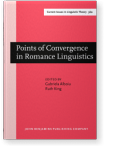Chapter 11
Value and cardinality in the evaluation of bare singulars in Brazilian Portuguese
Previous studies have explored two semantic features – cardinality and volume – to shown that bare singulars such as banana in Eu comi banana (I ate banana) allows a count and a mass interpretation in Brazilian Portuguese. In this chapter we explore whether other features such as value impact the interpretation of such nouns. The results of our priming and judgment studies indicate that cardinality is grammatically more relevant than value when interpreting Brazilian Portuguese bare singulars. However, we found a significant increase in reaction times when value was primed early. Therefore, value plays a role in the processing of bare singulars.
Article outline
- 1.Introduction
- 2.Dimensions of comparison beyond cardinality
- 3.Studies
- 3.1Study 1: Truth value judgment task
- 3.1.1Materials and methods
- 3.1.2Results
- 3.2Study 2: Priming task
- 3.2.1Materials and methods
- 3.2.2Results
- 3.3Control items
- 3.3.1Materials and methods
- 3.3.2Results
- 4.Conclusions
-
Notes
-
References
References (23)
References
Barner, David & Jesse Snedeker. 2005. Quantity judgments and individuation: Evidence that mass nouns count. Cognition 97(1). 41–66. 

Beviláqua, Kayron & Roberta Pires de Oliveira. 2014. Brazilian bare phrases and referentiality: Evidences from an experiment. Revista Letras 90(2). 253–275. 

Beviláqua, Kayron, Suzi Lima & Roberta Pires de Oliveira. 2016. Bare Nouns in Brazilian Portuguese: An experimental study on grinding. Baltic International Yearbook of Cognition, Logic and Communication 11(1). 2. 1–25. 

Doetjes, Jenny Sandra. 1997. Quantifiers and selection: On the distribution of quantifying expressions in French, Dutch and English. The Hague: Holland Academic Graphics.
Giralt, Nuria, & Paul Bloom. 2000. How special are objects? Children’s reasoning about objects, parts, and holes. Psychological Science 11(6). 497–501. 

Gleason, Henry Allan. 1965. Linguistics and English grammar. New York: Holt, Rinehart and Winston.
Grimm, Scott & Beth Levin. 2012. Who has more furniture? An exploration of the bases for comparison. Paper presented at Communication au colloque Massif/comptable en linguistique, philosophie et sciences, Paris, France, December 19–21.
Gutheil, Grant, Paul Bloom, Nohemy Valderrama & Rebecca Freedman. 2004. The role of historical intuitions in children’s and adults’ naming of artifacts. Cognition 91(1). 23–42. 

Lima, Suzi. 2014. The grammar of individuation and counting. Amherst, MA: University of Massachusetts Amherst dissertation.
Lima, Suzi. 2019. Processing coercion in Brazilian Portuguese: grinding objects and packaging substances. In Katy Carlson, Charles Clifton, Jr. & Janet Dean Fodor (eds.), Grammatical approaches to language processing – Essays in honor of Lyn Frazier, 209–224. Cham, Switzerland: Springer. 

Lima, Suzi Oliveira & Ana Paula Quadros Gomes. 2016. The interpretation of Brazilian Portuguese bare singulars in neutral contexts. Revista Letras 93. 193–209. 

Menuzzi, Sérgio de Moura, Maria Cristina Figueiredo Silva & Jenny Doetjes. 2015. Subject bare singulars in Brazilian Portuguese and information structure. Journal of Portuguese Linguistics 14(1). 7–44. 

Oggiani, Morgas C. 2011. On discourse referential properties of bare singulars in Spanish. Utrecht, Netherlands: Utrecht University Master’s thesis.
Paraguassu-Martins, Nize & Ana Müller. 2007. A distinção contável-massivo e a expressão de número no sistema nominal. Revista Delta 23. 65–83. 

Pelletier, Francis Jeffrey. 1979. Non-singular reference: some preliminaries. In Francis Jeffrey Pelletier (ed.), Mass terms: Some philosophical problems, 1–14. Dordrecht: Springer. 

Pires de Oliveira, Roberta. 2014. Dobras e redobras do singular nu: costurando a semântica através das línguas. Porto Alegre: EDIPUC-RS.
Pires de Oliveira, Roberta & Luisandro Mendes De Souza. 2013. ‘O singular nu e a comparação: uma proposta de derivação semântica’. Revista LinguíStica 9(1). 31–54.
Pires de Oliveira, Roberta & Susan Rothstein. 2011. Bare singular noun phrases are mass in Brazilian Portuguese. Lingua 121(15). 2153–2175. 

Santana, Raíssa Silva & Elaine Grolla. 2018. The acceptability of subject bare singulars in Brazilian Portuguese. Revista LinguíStica 14. 194–214. 

Schwarzschild, Roger. 2011. Stubborn distributivity, multiparticipant nouns and the count/mass distinction. In Suzi Lima, Kevin Mullin & Brian Smith (eds.), Proceedings of the 39th Annual Meeting of the North East Linguistic Society (NELS), Volume 2, 661–678. Amherst, MA: Graduate Linguistics Students Association, University of Massachusetts Amherst.
Shipley, Elizabeth F., & Barbara Shepperson. 1990. Countable entities: Developmental changes. Cognition 34(2). 109–136. 

Srinivasan, Mahesh, Eleanor Chestnut, Peggy Li & David Barner. 2013. Sortal concepts and pragmatic inference in children’s early quantification of objects. Cognitive psychology 66(3). 302–326. 

Wiese, Heike & Joan Maling. 2005. Beers, kaffi, and schnaps: Different grammatical options for restaurant talk coercions in three Germanic languages. Journal of Germanic Linguistics 17(1). 1–38. 

